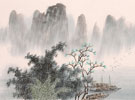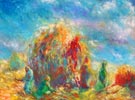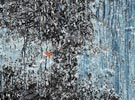Deep into his view, Liu Xuguang does not believe that the traditional ink painting is competent for displaying the modern spirits; moreover, the form of western modern art, with its own cultural regulation, can not be simply copied over to depict the particularly “Chinese” method to view and control the world. The essence of Chinese culture has flown to the present through the historical channel and is still telling the story about today. “Thunder”—one piece of Liu Xuguang’s installation artwork in 1998—consists of three parts: visual image, material and symbolism. As the eye of the theme as well as a symbolic mark, the thunder image here derives itself from the rock painting in pattern and Chinese ancient sacrificing and worshiping in connotation. The material includes the Rice paper for pattern-molding, ink wash and mineral pigment both for mystery-building. Considering the successive consistency between image and material, the primitive sacrificing stands for the primeval man’s way to know the world with patterns and marks being its substantial forms. Then, the paper molding is indicative of the continuous vein from primitiveness to civilization. This alteration from Chinese primeval culture to traditional civilization or specifically from natural worshipping to humanistic spirit manifests the relationship between man and nature, which is regretfully absent from the present.
Liu Xuguang’s application of the post-modern expression method is not a mere language problem but a creative way to describe the present existence. It is from the demand of the present reality that the significance of tradition springs up; at the same time, it is also implied that inheriting classic paintings simply and impractically does not make any sense to artistic and cultural development. The nature of the ink painting, which Liu Xuguang has been persistently seeking for, certainly depends on its material body but meanwhile surpasses the painting itself. In other words, the artwork on paper by Liu Xuguang (if it can still be called “ink painting”) is a question or reflection on its own nature. However, one can not make an interpretation of Liu’s art without a good understanding of his conception and thoughts. Whereas the conceptional ink painting does not necessarily require a hermeneutical explanation, its objective nature lies hidden behind the surface of the ink and wash. Since the civilization progress is to be defined by the tracks or marks of human impact on nature, Liu Xuguang abstracts these marks and entrusts them with different connotation. Thus, his serial artwork, “Marks”, retains the materials of ink and wash but not its artistic forms. To some extent, Liu’s intentional renouncement of the traditional forms results from his belief that those of modern arts can better serve the demand to convey the spirit of Chinese culture. The picture of “Marks” is full of many a Chinese character “Bu卜”, which are distributed out of order. The character “Bu卜”, not being a simple abstract mark, has at least two layers of implication: firstly, “卜”, with “divination” as one of its Chinese senses, represents the most primitive cosmological view in Chinese culture and just contains the “true nature” Liu Xuguang is always questing for; secondly, the very vertical line and dot in writing “卜” are the basic components of the ink painting, and therefore, the whole picture becomes a dense network of such a one-line-plus-one-dot writing structures. Liu Xuguang’s art is complex in that every image or pattern inside has its thinking origin. Even a simple presentation involves an ultimate meditation on the heaven, the earth and the mankind. With the creation of forms being the nature of art and the thinking of life and humanity at the core of culture respectively, Liu Xuguang is continuously searching for the local spiritual source by means of his own artistic language and approaching the harmony between form and idea in the end.
From: Limit Challengers By Yi Yin




